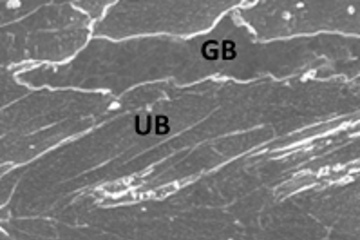All genres
461.
Journal Article
Magnetic microstructure in a stress-annealed Fe73.5Si15.5B7Nb3Cu1 soft magnetic alloy observed using off-axis electron holography and Lorentz microscopy. AIP Advances 6 (5), 056501 (2016)
462.
Journal Article
Formation of nanosized grain structure in martensitic 100Cr6 bearing steels upon rolling contact loading studied by atom probe tomography. Materials Science and Technology 32 (11), pp. 1100 - 1105 (2016)
463.
Journal Article
Elemental partitioning, lattice misfit and creep behaviour of Cr containing γ′ strengthened Co base superalloys. Materials Science and Technology 32 (3), pp. 220 - 225 (2016)
464.
Journal Article
Electronic hybridisation implications for the damage-tolerance of thin film metallic glasses. Scientific Reports 6, 36556 , pp. 1 - 12 (2016)
465.
Journal Article
Growth of bainitic ferrite and carbon partitioning during the early stages of bainite transformation in a 2 mass silicon steel studied by in situ neutron diffraction, TEM and APT. Journal of Applied Crystallography 49, pp. 399 - 414 (2016)
466.
Journal Article
Complex Nanotwin Substructure of an Asymmetric Σ9 Tilt Grain Boundary in a Silicon Polycrystal. Physical Review Letters 115 (23), 235502 (2015)
467.
Journal Article
Guided mass spectrum labelling in atom probe tomography. Ultramicroscopy 159 (2), pp. 338 - 345 (2015)
468.
Journal Article
Atomic scale investigation of non-equilibrium segregation of boron in a quenched Mo-free martensitic steel. Ultramicroscopy 159, pp. 240 - 247 (2015)
469.
Journal Article
Atomic scale study of CU clustering and pseudo-homogeneous Fe-Si nanocrystallization in soft magnetic FeSiNbB(CU) alloys. Ultramicroscopy 159 (2), pp. 285 - 291 (2015)
470.
Journal Article
Grain boundary segregation in multicrystalline silicon: correlative characterization by EBSD, EBIC, and atom probe tomography. Progress in Photovoltaics: Research and Applications 23 (12), pp. 1742 - 1753 (2015)
471.
Journal Article
Dynamic strain-induced transformation: An atomic scale investigation. Scripta Materialia 109, pp. 23 - 27 (2015)
472.
Journal Article
Autonomous Repair Mechanism of Creep Damage in Fe–Au and Fe–Au–B–N Alloys. Metallurgical and Materials Transactions a-Physical Metallurgy and Materials Science 46 (12), pp. 5656 - 5670 (2015)
473.
Journal Article
Non-equiatomic high entropy alloys: Approach towards rapid alloy screening and property-oriented design. Materials Science and Engineering A: Structural Materials Properties Microstructure and Processing 648, pp. 183 - 192 (2015)
474.
Journal Article
Deformation mechanism of ω-enriched Ti–Nb-based gum metal: Dislocation channeling and deformation induced ω–β transformation. Acta Materialia 100, 12375, pp. 290 - 300 (2015)
475.
Journal Article
Analytical bounds of in-plane Young’s modulus and full-field simulations of two-dimensional monocrystalline stochastic honeycomb structures. Computational Materials Science 109, pp. 323 - 329 (2015)
476.
Journal Article
Ab initio thermodynamics of the CoCrFeMnNi high entropy alloy: Importance of entropy contributions beyond the configurational one. Acta Materialia 100, pp. 90 - 97 (2015)
477.
Journal Article
The influence of stacking fault energy on the microstructural and strainhardening evolution of Fe–Mn–Al–Si steels during tensile deformation. Acta Materialia 100, pp. 178 - 190 (2015)
478.
Journal Article
Relationship Between Damping Capacity and Variations of Vacancies Concentration and Segregation of Carbon Atom in an Fe–Mn Alloy. Metallurgical and Materials Transactions a-Physical Metallurgy and Materials Science 46A (11), pp. 4828 - 4833 (2015)
479.
Journal Article
Assessment of geometrically necessary dislocation levels derived by 3D EBSD. Acta Materialia 99, pp. 402 - 414 (2015)
480.
Journal Article
Size and orientation effects in partial dislocation-mediated deformation of twinning-induced plasticity steel micro-pillars. Acta Materialia 98, 12304, pp. 391 - 404 (2015)











